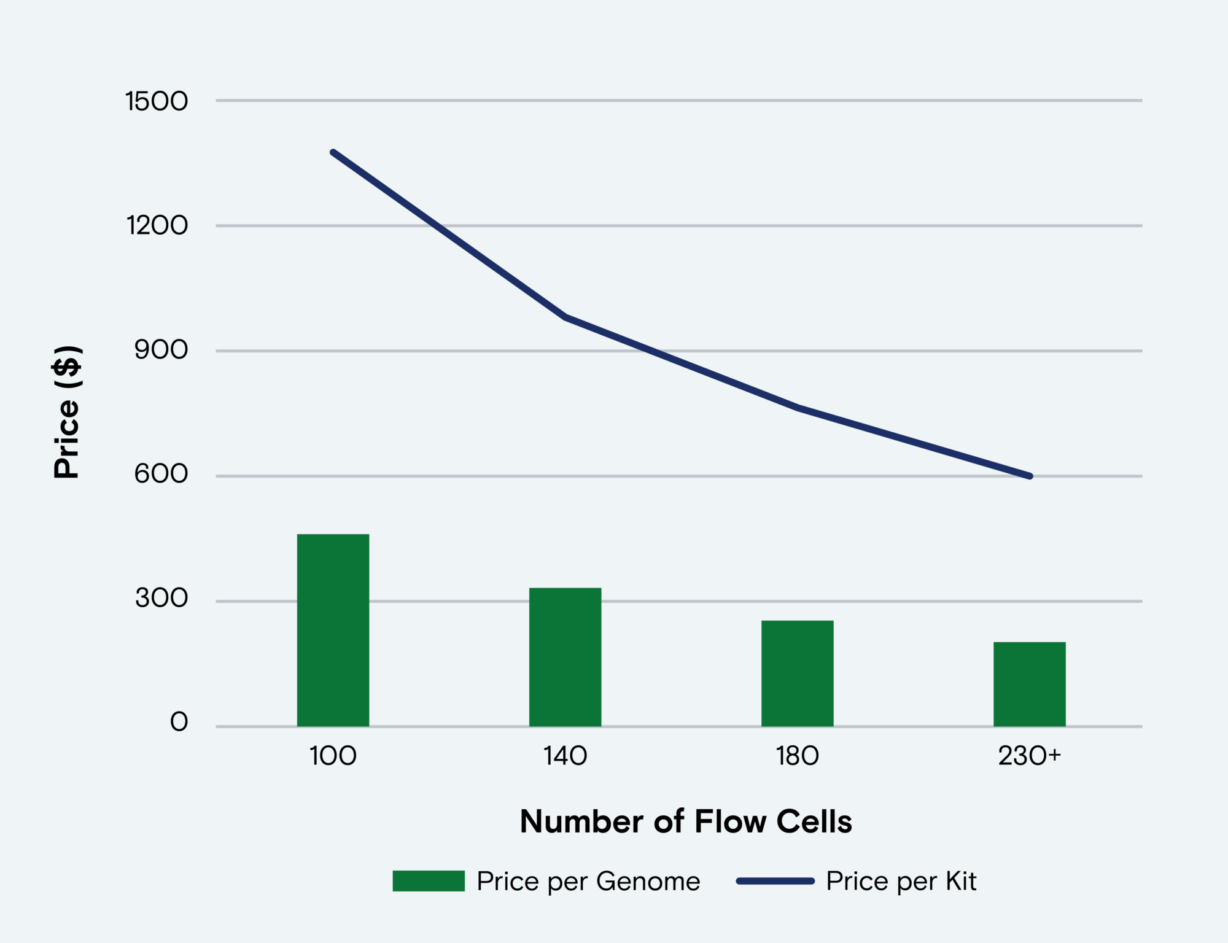Different sequencing applications have different needs. Metagenome taxonomic profiling, for example, benefits from low error rates and has variable output requirements, while whole-genome sequencing (WGS) benefits from high accuracy at high throughput. What these applications did not have in common—until now—is a workable price point, one that adapts to low, medium, and high throughput.
Recent advancements in sequencing have reduced prices at all experiment scales without needing to batch large numbers of samples. A natural extension of this innovation is the $200 Genome, a program that decreases the cost of a 2 x 150 run to drive WGS and WGS-equivalent applications such as counting and single-cell, enabling higher volume sequencing for mid-throughput labs.
Eight-fold lower sequencing costs compared to NextSeq 2000
A run under the $200 Genome program outputs 300–330 Gb of data, sequencing three genomes or equivalent on one flow cell at 30–35x coverage. At this output, cost is as low as $200 per genome or $2 per gigabase. Essentially, this program presents an opportunity for a benchtop sequencer to reduce costs by 8-fold compared to competitor systems.* The more you sequence, the more you save.

Starting with as few as ~1000 genomes annually and increasing up to ~6000, all outputs benefit from instrument redundancy, flexibility, and value, with maximum savings at the high end of the range. Delivering the same value as larger platforms with commitments of tens of thousands of genomes per year, the $200 Genome scales these savings for thousands of genomes per year.
A look at more specific numbers and use cases
Threshold usage of 100 flow cells per quarter equals an effective sequencing kit price of $1380, which is slightly lower than list price. Ramping up to moderate usage allows more instruments and a big drop in effective kit price, down to $767, or less than half the list price. Maximum usage, which maxes out at ≥ 230 flow cells per quarter, ups the instrument count to 3–5 and achieves the $200 genome. In pure dollars and cents, this threshold translates to an annual kit commitment of only ~$500,000. Multiple instruments help achieve the highest value with a bonus of greater flexibility, particularly for labs sequencing genomes alongside other applications.
Table 1: Example use cases show savings at every level
Usage | Flow Cells per Quarter | Genomes per Quarter | Effective Kit Price ($) | Per-Genome Price ($) | AVITI Systems |
Threshold | 100 | 300 | 1380 | 460 | 2 |
Moderate | 180 | 540 | 767 | 255 | 3–4 |
Maximum | ≥ 230 | ≥ 690 | 600 | 200 | 3–5 |
For perspective on instrument amortization, sequencing genomes under the usual terms with an AVITI System and service contract adds ~$72 per genome. That number still represents tremendous per-genome value with only moderate usage. For genomes and genome equivalents, the $200 Genome drives accessibility and flexibility for high-throughput single-cell and counting applications, cell-free DNA (cfDNA), and other conditions that require tremendous data output, anywhere from tens of thousands of gigabases to the low hundreds of thousands.
Threshold usage of the program still drives exceptional value. At 1380 genomes per year, for example, it is a $400 genome program. As you exceed 2760 genomes annually, the $200 genome becomes accessible to as many genomes as you can run, depending on the number of available instruments. Although using fewer kits raises the effective kit price, it remains a significant discount relative to list pricing and competitors.
Exceptional value for high volume
The $200 Genome program empowers moderate throughput labs, offering significant benefits to labs with enough genomes. More specifically, labs without the throughput or ability to batch hundreds of samples per run still deserve the flexibility of daily run starts and rapid trio sequencing. Labs sequencing even modest amounts of genomes in a year (in the low thousands) no longer need a NovaSeq—this program competes favorably. For day-to-day sequencing that falls outside the $200 Genome sweet spot, Element continues to offer flexibility, value, and performance.
* Based on equivalent NextSeq 2000 P3 data at list price. Comparison does not include preparation, analysis, and warranty costs.